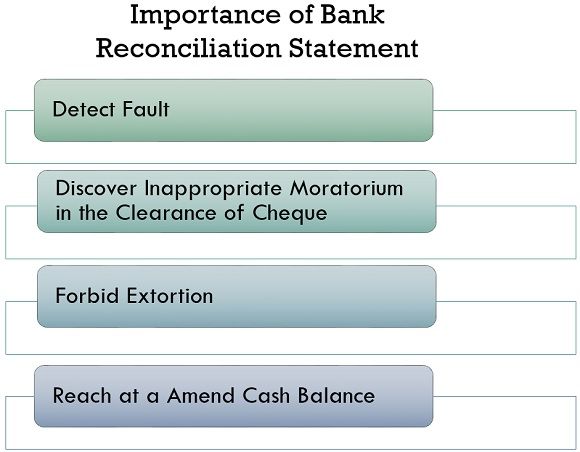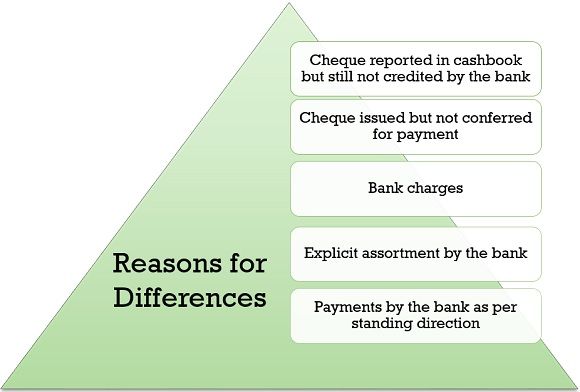Definition: Bank reconciliation statement is a statement made by a firm to obtain the balance of the passbook through the balance of cash book by making certain adjustments or finding the balance of the cash book by taking the balance of passbook on a precise date.
It is prepared to understand the precise position of the transactions and to make sure that no blunder has committed, and clarify the reason behind the difference of the balances of the cash book and the passbook if any.
Generally, a businessman or a firm makes a transaction from their bank account for which a current account is opened in a bank with a firm’s name. However, all the transactions are recorded by both the firm and the bank in their records. But, it is not necessary that both will record the transaction on the same date as most of the banking transactions are made by Cheque which may take longer time to clear in a bank, but the firm will record it on the date of issue of Cheque.
Thus, before preparing the final books of accounts, the firms prepare the Bank reconciliation statement to be sure about the correctness of the financial transactions took place during the year.
Content: Bank Reconciliation Statement
- What cashbook and passbook are?
- Format of Bank Reconciliation Statement
- Process of preparing the Bank Reconciliation Statement
- Importance of Bank Reconciliation Statement
- Reasons for differences in the cashbook and passbook balances
- Conclusion
What cashbook and passbook are?
- Passbook: A passbook is a bank’s recording statement in which they record the transactions of the clients, and a copy of it is allotted to a client in the form of the bank statement or a booklet.
- Cashbook: A cashbook is a book maintained by the firm to record all the cash and bank transactions occurred in a business in a financial year.
Format of Bank Reconciliation Statement
By taking the Debit balance of cash book
| Particulars | Amount (₹) |
|---|---|
| Debit balance of cash book | xxx |
| (-) Entry done in cash book, but not recorded in passbook | (xxx) |
| (+) Cheque issued but not presented for payment | xxx |
| (+) Income received entered in passbook, but not in cashbook | xxx |
| (-) Bank charges not entered in cash book, but entered in passbook. | (xxx) |
| (+) Cheque directly deposited by the customer in a bank not recorded in the cash book | xxx |
| (-) Cheque deposited but dishonored. | (xxx) |
| (+) Amount paid directly to the authorities by the bank. | xxx |
| Credit balance of pass book (if positive balance) | xxxx |
| Debit balance of pass book (if negative balance) | (xxxx) |
(In case of overdraft or negative balance of cash book, the opening balance should be recorded as negative balance, else assume the problem is that of debit cash balance type and treat accordingly)
By taking Credit balance of passbook
| Particulars | Amount (₹) |
|---|---|
| Credit balance of pass book | xxx |
| (+) Cheque deposited but not cleared by bank | xxx |
| (-) Cheque expressed but not conferred for payment | (xxx) |
| (-) Income earned but listed in passbook only, not in cash book | (xxx) |
| (+) Bank charges listed in passbook but not in cash book | xxx |
| (-) Customer directly deposited the cheque in bank not entered in cash book. | (xxx) |
| (+) Cheque accumatted in the bank, dishonoured | xxx |
| (-) Amount directly paid to the authorities by the bank | (xxx) |
| Debit balance of cash book (if positive balance) | xxxx |
| Credit balance of cash book (if negative balance | (xxxx) |
(In case of overdraft or negative balance of passbook, the opening balance should be recorded as negative balance, else assume the problem is that of credit cash balance type and treat accordingly)
Process of Preparing the Bank Reconciliation Statement
The bank frequently sends the statement to the customers displaying the position of their accounts. Generally, bank passbook is maintained through which bank notify their customer about their account balance and keep its copy at a bank to make sure that the balance of passbook should tally with the balance of the cashbook.
But, sometimes there are some differences even there was no mistake because of some reasons for which Bank reconciliation statement needs to be prepared for correcting these differences arriving because of some entries made in the cash book and not in the passbook. Similarly, some entries have recorded in passbook but not in the cash book.
Following procedure should be followed for preparing the Bank Reconciliation Statement:
- Always prefer passbook as a base to match the transactions.
- Take the bank statement of the firm from the bank for the current year and start matching transactions from the cash book maintained by the firm. The entry which is debited in the passbook must be credited to the cashbook, and vis-a-versa the entry which is credited in passbook should be debited in the cash book.
- Identify the mismatch transactions and note them to make adjustments in it.
- Identify the extra entries in the passbook that are not entered in the cash book such as bank interest received, amount directly deposited by the customers in the firm’s bank account.
- Take the balance of any of the book as a base and make relevant adjustments to match the balances of both the books. At last, the debit balance of the cash book should be equal to the credit balance of the passbook and vis-a-versa.
Importance of Bank Reconciliation Statement
Importance of the Bank Reconciliation Statement can be understood with the following points:

1. Detect fault: If there has been an error by the accountant while preparing cash book or by the bank, while preparing the customer’s account in its book, they will be identified by preparing bank reconciliation statement.
2.Discover inappropriate moratorium in the clearance of Cheque: Due of various reasons the Cheque deposited in bank delayed for clearing which shows the difference in the cash book and bank balance for identifying such situations Bank reconciliation statement is helpful. It may be because of the outstation Cheque, which takes a long time for clearing the Cheque; if we prepare the Bank reconciliation statement, we can try to ascertain the undue delay.
3. Forbid extortion: If the accountant makes an entry in the cash book of the cash received, but not deposited the amount in the bank it becomes difficult for the proprietor to find the reason of the difference, but if the bank reconciliation statement is inclined, the fraud will easily be recognized.
4. Reach at an amend cash balance: With the help of Bank reconciliation statement, we arrive at the balance that should display in the balance sheet at the end of the year. We consider all the errors, income and expenses and pass necessary entries in the cash book and arrive at the correct bank balance.
Reasons for Differences in the cashbook and passbook balances
Following are the major reasons for differences in the cashbook and passbook balances:

- Cheque reported in cashbook but still not credited by the bank: As soon as the Cheques get received, immediate entry is made in the cash book, but it may take a day or more to send Cheques to the bank, although the bank does not credit the customer’s account until the Cheque are realized, and if the Cheque is of another bank it takes a long time for the realization. Meanwhile, the balance of the cash book and the passbook will differ.
- Cheque issued but not conferred for payment: At the time of issue of Cheque, immediate entry is made in the cash book; still banks make no entry until the Cheque gets presented for the payment in the bank which shows the higher balance in the bank and less balance in the cash book.
- Bank charges: The charges rendered for the bank’s services are termed as bank charges and in case of the bank overdraft the bank also charges the interest. These bank charges and interest are enrolled in the passbook, and the entry gets listed in the cash book only when passbook is acknowledged.
- Explicit assortment by the bank: The banks are generally allocated to gather interest among the securities or dividends on shares. The bank will credit the client’s account as soon as the sum is received, but the entry by the client in the cash book must anticipate receipt of advice by the customer from the bank.
- Payments by the bank as per standing direction: The bank can also generate payments as per the client’s instructions or against any appropriate direction like payment on demonstrating the documents for goods supply for which letter of credit has been opened already. In such cases entries in the cash book are made on the certificate of advice from the bank.
Conclusion
Bank reconciliation statement is a statement prepared by the firm for identifying the cause of difference between the bank balance as per cash book and that shown in passbook on a particular date.
Leave a Reply